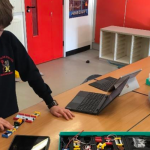The amount of time people can give their undivided attention to a task, or in short ¨attention span¨, can differ with age in children and for some kids, this time span can be quite short. Read further to learn what is ¨attention span¨, how it changes from age to age, what are the symptoms for a short attention span and small tips for improving it.
What Is the Meaning of ¨Attention Span¨ and When Is It ¨Short¨?
¨Attention span¨ is the name given to the amount of time a person can give attention to a certain task without getting distracted. As it is easier and more possible to sharpen and improve attention span during childhood, it gains extra importance in the case of children.
Having a normal attention span is crucial for children as it affects their academic lives, relationships with their peers and even their careers in the long run. Having a short attention span means that specific amount of time given to a task in hand being shorter than it normally is. As it can have such a huge impact in their overall lives, it is important to address and accept whether a child has a short attention span and seek treatment if needed.
What Is the Average Attention Span by Ages?
Even though every child is different, experts give a broad formula to determine the average attention span by age. Experts state that two or three minutes per year of their age can give a broad idea for a child’s average attention span. Some experts even take it as far as five minutes per age but if we stick to the general formula and accept the first one, here is a list for average attention span by ages:
2-year-old – 4 to 6 minutes
3-year-old—6 to 9 minutes
4-year-old—8 to 12 minutes
5-year-old—10 to 15 minutes
6-year-old—12 to 18 minutes.
As the child’s age progresses, so does the attention span. Yet, like we mentioned before, every child is different. So, rather than taking this list as an invariable basis and molding your child according to it, observe your child and try to come up with your own basis for an individualized attention span for them.
What Are the Common Symptoms to Detect a Short Attention Span in Kids?
Every child can show their lack of focus and discontent in different ways but the following 6 can be counted among the most common ones.
1. Lack of eye contact
Eye contact is everything, not only in children but for everyone. So, if you realize your child stops making eye contact with you at some point during finishing a task, you may be right to think that their attention is long gone.
2. Not being able to sit still
Constant need to move like restlessness and fidgeting is common among children who want to show that they no longer have an interest in doing the task in hand.
3. Constantly forgetting what to do
If at some point, your child starts asking the same things over and over again, or if ¨What was it again?¨s are floating around the room, that means that most probably your child has lost their attention.
4. Making frequent small mistakes that normally they wouldn’t do
Making small mistakes is okay, yet if they are too frequent and too obvious, it is a common sign that the focus of your child is somehow distracted.
5. Not seeming to listen or not answering accordingly
If you realize that your child only ¨seems¨ to be listening to you, ask a simple question to see if they answer accordingly. If not, you’re right, they are already distracted.
6. Not being able to finish off tasks at time or not being able to finish them at all
Deadlines, even for children, can bring about a bit of stress, but they also create a sense of responsibility and improve focus as well as they specify a time frame for the goal. If your child keeps getting out of that time frame or start giving up before finishing a task, it means that they lost their attention.
These 6 symptoms can be seen in every child and every person from time to time and they don’t necessarily mean that your child has a certain attention problem. Yet, if they occur constantly, they might be good starting points to think about whether your child has a short attention span and might also lead you to look for what can be the causes for it and ways to improve them.
What Can Be the Causes for a Short Attention Span?
There can be many causes for a child’s having a short attention span from a simple reason like a sibling distracting the other or the child being hungry at that moment to more serious ones like ADHD (Attention Deficit Hyperactivity Disorder).
As we live in a world dominated by technology, outside technological stimuli can be counted as the number one reason for a short attention span in today’s children. However, the place of technology in education is increasingly gaining significance, and with the right attitude you can transform your child’s relationship to digital devices and actually reap the benefits of technology.
It is crucial to know whether a child’s short attention span stems from more common and less serious ones like technological distractions or from more serious and treatment requiring ones like ADHD as the latter requires third-party help from a pediatrician or a specialist.
How to Increase and Improve Your Child’s Low Attention Span?
Having a child with a low attention span can be tiring and even daunting sometimes. But, don’t worry! Improving short attention span is always possible. Here are 10 ways to help you improve your child’s attention span:
1. Be present, be attentive, be collaborative.
But of course, to a certain degree. Rather than issuing commands to your child from a different room or while looking at your phone, be at your child’s side while they are dealing with a task.
Make them feel that you are there for them if they need help, collaborate with them if needed. Yet, after some point, don’t make this a ¨must¨ as to make them feel like they can’t succeed at anything without your presence. Don’t forget that after all, your child is an individual by himself or herself. Make them feel like you are there when needed, not always.
2. Know your child, familiarize with their needs and wants.
Like we said earlier, every child is different. Get to know your child and ask them what they want or what they need so that you know what would be the right place or time for them to start and finish a task whether it be doing homework or playing a game. Remember, the reason for a short attention span need not always be something like ADHD, a simple hunger or a need for a change of scenery can also be a cause.
3. Be creative. Creativity brings joy. Joy brings attention.
Rather than setting rules and asking your child to follow them, try to be creative during a task. You can turn a math problem into a story, or gamify a rather boring task so that you can keep your child’s attention at the moment. The more they have fun, the more they will want to spend time continuing doing that task. Remember, when you are dealing with a child, gamifying is the ultimate savior.
4. Stay away from alluring your child with a reward every time.
Promising a reward at the end every time your child starts a task isn’t a healthy way to make them pay attention to something. Such an attitude might lead the child to expect gifts and rewards for even the smallest and necessary things they are supposed to do. Remember, life doesn’t work that way. Encouragement doesn’t necessarily have to be a material thing.
5. Motivate their effort—either with words, actions or even with a look.
As offering them a gift every time they finish a task isn’t a healthy attitude, it’s also not healthy to make children feel underappreciated. Encourage your child’s efforts rather than the final product as much as possible. Remember, what matters is not the destination; it’s the journey. Do not criticize or discourage; be constructive.
6. Normalize your expectations; take breaks.
Always be aware of the fact that every child is different, so don’t compare your child’s attention span with other kids’, not even with a brother or a sister. Do not expect them to stay focused like an adult and take frequent breaks so that they don’t feel overwhelmed. Remember, everyone needs a break at some point.
7. Find a physical activity through which they can release their surplus energy.
Children are fidgety. And if that energy that makes them fidgety isn’t somehow discharged, it comes out at the most unwanted moments like during finishing a homework or a task that needs to be done. During their free time and breaks, direct their energy to a certain physical activity or various ones to make sure they are spending that extra energy in the right way.
8. Try to come up with a routine.
Routine is everything, especially with kids. Rather than trying to get your child start or finish a task whenever they want or whenever you want, set a routine. That works for both of you and your child will know that part of the day is allocated for that specific task.
9. Turn the outer distractions into outer advantages.
During a task, if you realize that your child is distracted by an outside stimuli, like a bird in the window or a sibling eating an ice-cream and you don’t seem to bring them to the moment no matter how much you say ¨Focus!¨, the solution is simple: turn it into an object to be earned. Tell your child that it is only possible to touch that bird or eat that ice-cream once they finish off the task and you’ll see that the word ¨Focus¨ won’t be needed again.
10. Supervise their screen time.
All of us can be distracted and feel that our attention span is shorter than it used to be or should be from time to time. When it comes to children whose minds are working faster than we could imagine, it is highly normal they lose their focus and attention easier and faster than adults or some of their peers.
We live in a world of technology and it is almost impossible to keep children away from screens. Rather than prohibiting screen time altogether and making it an object of greater desire and wonder for your kid, focus on ways to manage screen time for kids. You can set up a regulated screen time and direct them towards both enjoyable and educational applications.
Most of the time a short attention span can be improved with certain attitude and environment enhancements. As the child grows, so does his or her sense of responsibility and as the formula shows, the attention span doesn’t stay the same for a lifetime.



